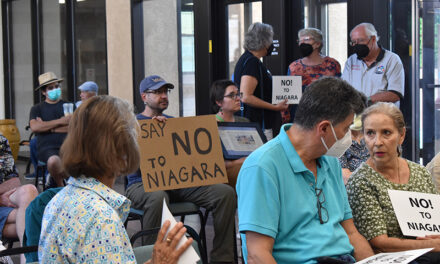Santa Fe
With rainfall sparse, rivers and reservoirs low and fire danger high, Gov. Gary Johnson has declared a drought emergency across New Mexico.
With the declaration, “triggers are in place to release state funds to help alleviate the problem,” Johnson said in a telephone press conference Friday.
“These are extreme conditions, a state of emergency, but we want people to know that New Mexico is open for business. Tourists still should come. They will not notice the difference. Citizens need to be aware and conserve water. But they should continue to enjoy the state.”
The state has $94 million dollars in an emergency fund, he said.
That money could be used for firefighting, to haul water to livestock and wildlife and for technical assistance for municipalities and counties.
The state’s drought plan will be activated and updated to meet current conditions, Johnson said.
“We are prepared for any emergency that could arise. If it starts to rain tomorrow, nothing may be needed. But we want to be ready. We are ready,” he said.
He plans to meet with community leaders to explain the emergency.
This week’s declaration laid the groundwork for placing water restrictions on communities in May.
Several members of Johnson’s cabinet, as well as state officials, accompanied him for the conference.
Betty Rivera, chairwoman of the Drought Task Force, said precipitation is 58 percent of normal and called it “a very, very serious condition.”
“Conditions are rapidly deteriorating,” said Ed Polasko, a meteorologist with the National Weather Service.
Northwest New Mexico is experiencing severe drought, as is the southeast. In the northwest, the conditions are called extreme drought.
Statewide average precipitation is 58 percent of normal, and some areas, such as the Jemez Mountains, are drier than that, he said.
The stream flow is the lowest in 45 years, and that’s likely to persist, Polasko said.
Even if the monsoon season brings rain, “it will not do a whole lot for the reservoir or stream flows,” he said. They need more water than the monsoons provide in a short time.
Tom Turney, state engineer, said the snow pack is below normal and “the flows of streams are 20 to 30 percent of average.”
Reservoirs are declining, he said.
Cities must make plans to conserve water. “Supply and demand should be analyzed and plans implemented,” he said.
Craig Roepke, a hydrologist with the Interstate Stream Commission, said federal money is available for agricultural uses.
“Agriculture uses 75 percent of the state’s water,” he noted, and he praised the Middle Rio Grande Conservancy for beginning a rotation, assigning farmers times to use water.
He urged farmers to adhere to the rotation and consider the needs of other farmers.
Pete Maggiore, cabinet secretary for the Environment Department, said the priority is to assure the quality and quantity of drinking water. Local community governments and municipalities must keep local capacities in line, he said.
All permits for controlled burns have been rescinded and no new ones will be issued.
Ernesto Rodriguez, emergency management section chief of the Office of Emergency Services and Security, said low-interest loans are available for those suffering financially from livestock loss and crop loss.
“Today’s declaration is the first step to lead us toward declaring a federal emergency,” he said, “making available 25 federal programs.”
Moisture three weeks ago made a difference in terms of conditions, but the forests are susceptible to dry timber, said Toby Martinez, state forester with the Forestry Department.
“I’m concerned about timber fires. I hope to catch them before they get away,” Martinez said.
Alice Darilek, water conservation coordinator for the state engineer, said people are being urged to be as water efficient as possible, using low-flow toilets, repairing leaky faucets and water leaks, taking short showers and watering plants only when they need it.
Also, wash only full loads of dishes or clothes, repair leaks in irrigation systems, water in the morning or evening and convert lawns to xeriscapes.
Municipalities need to know how to deal with drought. Next week, there will be drought workshops to begin explaining the situation.
State Engineer Tom Tuourney said 75 percent of community water is used on landscape.
“We have water, if we use it right. We are in the desert,” Johnson said.
The governor said he already has received requests for help from various communities.
In answer to a question, Johnson said the state must continue to do what’s necessary to keep the silvery minnow alive, and he hoped the drought would not force the state to compromise the needs of the fish.
Historically, New Mexico has seen dry and wet spells, and this drought is similar to others in the 1950s and in 1996.















